InSight leci na Marsa 05.05. o 11:05 z Vandenberg wystrzelona została RN Atlas-5/401, która wyniosła w T+1h 24' 20" na trajektorię
międzyplanetarną wiodącą ku Marsowi lądownik
InSight i dwa pikosatelity projektu
MarCO (Mars Cube One).
Był to pierwszy start na orbitę międzyplanetarną z tego kosmodromu.
http://lk.astronautilus.pl/n180501.htm#02

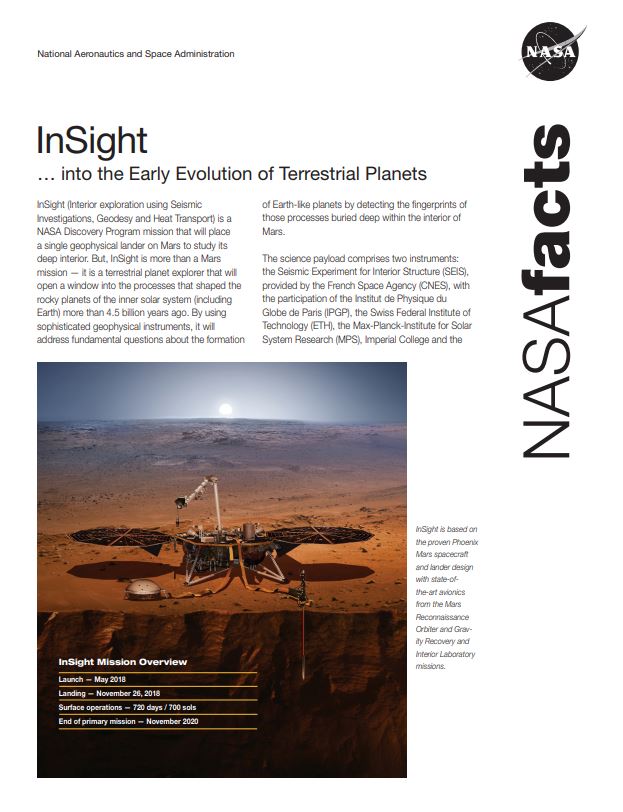 https://mars.nasa.gov/insight/multimedia/resources/Udany start misji InSight
https://mars.nasa.gov/insight/multimedia/resources/Udany start misji InSight BY REDAKCJA ON 5 MAJA 2018
 Start misji InSight / Credits - NASA TV
Start misji InSight / Credits - NASA TVPiątego maja ku Czerwonej Planecie wyruszyła misja InSight.
Do startu misji Interior Exploration using Seismic Investigations, Geodesy and Heat Transport (InSight) doszło 5 maja 2018 o godzinie 13:05 CEST z kosmodromu Vandenberg w Kalifornii. Lot rakiety Altas V przebiegł prawidłowo i InSight został umieszczony na prawidłowej orbicie wstępnej. O 14:23 rozpoczęło się drugie, 6 minutowe odpalenie stopnia Centaur, które wyniosło sondę na trajektorię międzyplanetarną. Przylot do Marsa zaplanowany jest na koniec listopada.
Lądownik InSight
od lutego przebywał w Vandenberg w Kalifornii. Start misji odbył się za pomocą rakiety Atlas V w konfiguracji 401. Choć Vandenberg nie oferuje optymalnej trajektorii lotu poza bezpośrednie otoczenie Ziemi, NASA zadecydowała o wykorzystaniu tego kosmodromu, gdyż rakieta Atlas 5 w konfiguracji 401 dysponuje nadwyżką “mocy” wystarczającą do wyniesienia dość małego lądownika (ważącego zaledwie 360 kg) jakim jest InSight. Start z Vandenbergu miał też inną korzyść: z Florydy w tym roku prawdopodobnie wystartuje rekordowa liczba rakiet, co oznacza problemy logistyczne.
https://www.youtube.com/watch?time_continue=11&v=O_D85bjcdXEPoczątkowa trajektoria lotu misji InSight / Credits –
United Launch AllianceWarto dodać, że część penetratora HP3, jednego z instrumentów sondy, zostało wykonane na zamówienie Niemieckiej Agencji Kosmicznej (DLR) przez polską spółkę Astronika. Penetrator HP3 jest jednym z podstawowych elementów misji InSight i jego zadaniem jest “wbicie się” na głębokość pięciu metrów w marsjański grunt. Urządzenie ma być uruchomione w pierwszym kwartale przyszłego roku, kilka miesięcy po lądowaniu InSight.
 Elementy urządzenia HP3 wykonane przez firmę Astronika / Credits - Astronika
Elementy urządzenia HP3 wykonane przez firmę Astronika / Credits - AstronikaOprócz InSight ku Czerwonej Planecie zostały wysłane zminiaturyzowane satelity typu CubeSat o nazwie Mars Cube One (MarCO). Celem misji MarCO jest test systemów komunikacji i orientacji małych satelitów w “głębokim kosmosie”, czyli przestrzeni z dala od Ziemi.
(PFA, NASA)
http://kosmonauta.net/2018/05/udany-start-misji-insight/http://naukawpolsce.pap.pl/aktualnosci/news%2C29375%2Cusa-na-marsa-wystartowala-misja-nasa-insight-z-urzadzeniem-z-polskiej-firmyhttp://www.urania.edu.pl/wiadomosci/wystartowala-misja-insight-ktora-zbada-wnetrze-marsa-4394.htmlAfter foggy departure, it’s clear sailing to Mars for InSight landerMay 5, 2018 Stephen Clark
 A fog layer at Vandenberg Air Force Base prevented nearby observers from viewing the launch of NASA’s InSight mission to Mars, but viewing points farther away from the launch site had clear skies. This long exposure photo was captured at Ventura, California. Credit: William G. Hartenstein
A fog layer at Vandenberg Air Force Base prevented nearby observers from viewing the launch of NASA’s InSight mission to Mars, but viewing points farther away from the launch site had clear skies. This long exposure photo was captured at Ventura, California. Credit: William G. Hartenstein(...) NASA Administrator Jim Bridenstine, who took office April 23, called to congratulate the NASA and ULA launch team from the agency’s headquarters in Washington.
“This is a big day,” Bridenstine said. “We’re going back to Mars. We did it from the West Coast, which is a first-ever.
“This is an extraordinary mission with a whole host of firsts,” he said. “It’s important for our country. It’s also important for the world, and it really establishes American leadership in a lot of ways.” (...)
 The Atlas 5 rocket carrying InSight lifts off from Vandenberg Air Force Base, California, in a veil of fog. Credit: United Launch Alliance
The Atlas 5 rocket carrying InSight lifts off from Vandenberg Air Force Base, California, in a veil of fog. Credit: United Launch AllianceInSight will conclude its 205-day interplanetary journey Monday, Nov. 26, with a dive into the Martian atmosphere. A thermal shield will protect the craft during descent, and a supersonic parachute and braking thrusters will slow InSight for a gentle touchdown at Elysium Planitia, an expansive equatorial plain that has not been visited by a previous spacecraft. (...)
Mission managers selected the nearly featureless landing target because of its safety. There are few surface hazards that could spell doom for InSight, and Banerdt, the mission’s chief scientist, calls it the “biggest parking lot on Mars.” (...)
The two-year delayed added roughly $150 million to InSight’s cost, which now sits at more than $993 million, including launch and operations expenses. That figure includes an investment valued at approximately $180 million from the French and German space agencies.
The twin MarCO spacecraft cost another $18.5 million, according to NASA.
One of InSight’s first jobs will be to take panoramic pictures to survey the landing site, a region unexplored by past Mars missions. InSight carries cameras based on technology originally developed for the Opportunity and Curiosity rovers, but with added capability for color imagery. (...)
https://spaceflightnow.com/2018/05/05/foggy-departure-kicks-off-insights-journey-to-mars/MarCO – Mars Cube One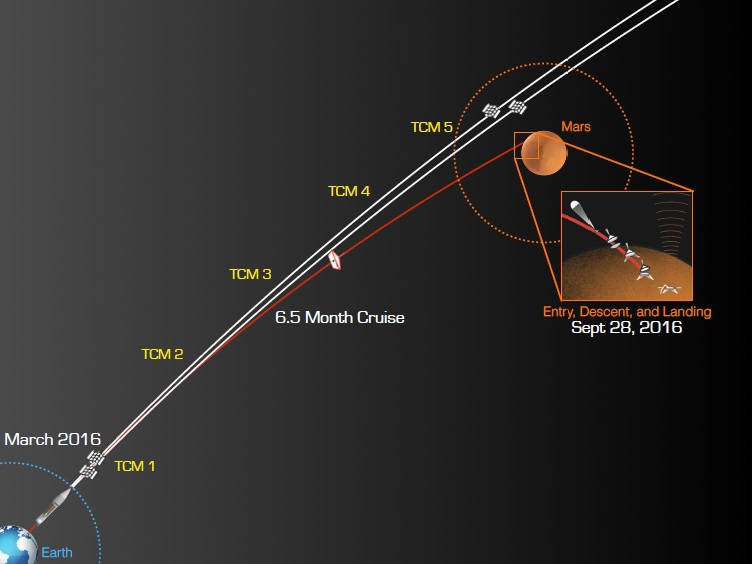 MarCO Mission Profile – Image: NASA
MarCO Mission Profile – Image: NASA(...) Chosen for the MarCO mission was Blue Canyon’s XACT (fleXible Attitude Control Technology) unit which includes a star tracker, inertial measurement sensors, coarse sun sensors and a three-axis reaction wheel assembly for actuation. The XACT unit takes up 0.5 Units of volume (10 x 10 x 5 centimeters) and weighs 0.91 Kilograms when flying in its baseline configuration, capable of a pointing accuracy of ±0.003 degrees on two axes and ±0.007 on the third. It uses a 12V power supply, supports slew rates of over 10° per second and has been rated for a five-year lifetime on Low Earth Orbit missions. (...)
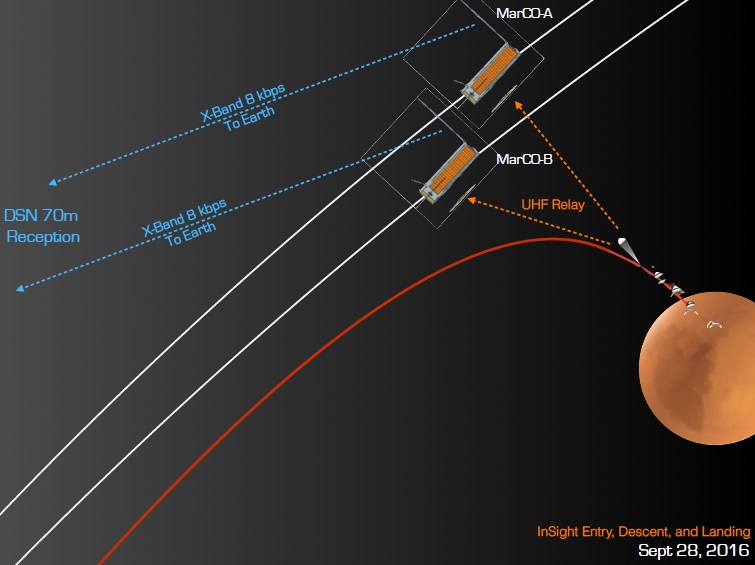 http://spaceflight101.com/insight/marco/http://spaceflight101.com/insight/
http://spaceflight101.com/insight/marco/http://spaceflight101.com/insight/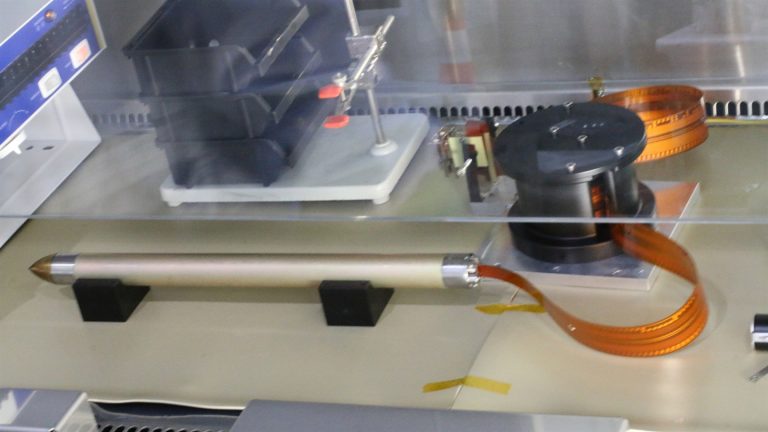 HP³ Mole – Photo: DLR/InSight Projecthttp://spaceflight101.com/insight/insight-instruments/
HP³ Mole – Photo: DLR/InSight Projecthttp://spaceflight101.com/insight/insight-instruments/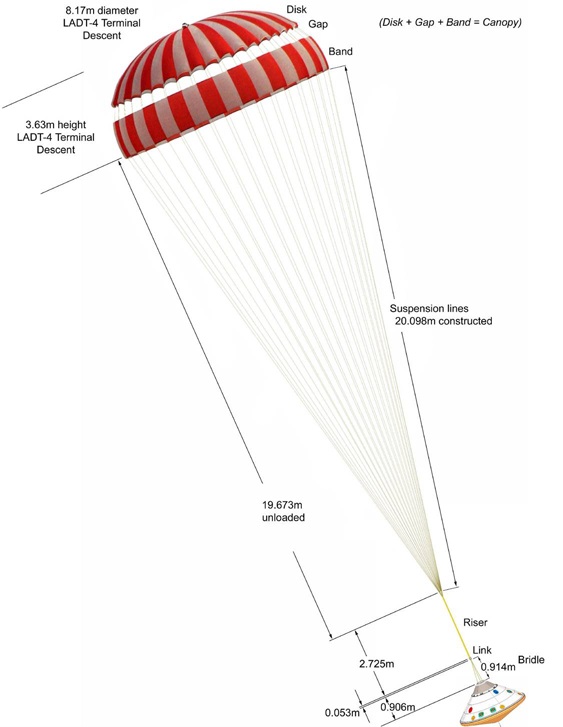 Image: NASA Langleyhttp://spaceflight101.com/insight/insight-spacecraft/NASA, ULA Launch Mission to Study How Mars Was Made
Image: NASA Langleyhttp://spaceflight101.com/insight/insight-spacecraft/NASA, ULA Launch Mission to Study How Mars Was MadeMAY 5, 2018
(...) InSight is scheduled to land on the Red Planet around 3 p.m. EST (noon PST) Nov. 26, where it will conduct science operations until Nov. 24, 2020, which equates to one year and 40 days on Mars, or nearly two Earth years.
"Scientists have been dreaming about doing seismology on Mars for years. In my case, I had that dream 40 years ago as a graduate student, and now that shared dream has been lofted through the clouds and into reality," said Bruce Banerdt, InSight principal investigator at JPL. (...)
https://www.jpl.nasa.gov/news/news.php?feature=7114Atlas 5 launches NASA InSight Mars landerby Jeff Foust — May 5, 2018
“Because the science team was closely tied to the instrumentation, and the instrumentation is coming almost exclusively from outside the United States, about two-thirds of the team is non-U.S. and about a third is U.S,” Banerdt said at the Mars Exploration Program Analysis Group meeting in Crystal City, Virginia, April 4. “I think that probably generated some resentment in the community.”
He said InSight is planning to address this with a participating scientist program, allowing scientists not involved with the instruments to join the mission as co-investigators. “I definitely want to strengthen U.S. representation on the science team,” he said. (...)
http://spacenews.com/atlas-5-launches-nasa-insight-mars-lander/InSight GO For May 5 Launch to Mars from California, But Fog May Prevent Anyone Seeing ItBy Paul Scott Anderson May 4th, 2018
InSight is not very large, but it carries an impressive array of instruments, including:
Grapple – Mechanism at the end of the IDA that grips the instruments during deployment
Heat Flow Probe – Hammering mechanism that pulls the temperature sensors down into the regolith
HP3 – Heat Flow and Physical Properties Package, the heat flow experiment
IDC – Instrument Deployment Camera, pointable medium-resolution camera
IDA – Instrument Deployment Arm
ICC – Instrument Context Camera, fixed wide-angle camera
Pressure Inlet – Wind-shielded opening for pressure sensor
RISE Antenna – X-band radio antenna for the Rotation and Interior Structure Experiment
SEIS – Seismic Experiment for Interior Structure, the seismometer
Tethers – Cables carrying electrical power, commands and data between the lander and instruments
TWINS – Temperature and Winds for InSight, environmental sensors
UHF Antenna – Antenna used for communication with orbital relay spacecraft
WTS – Wind and Thermal Shield protecting the seismometer from the environment
http://www.americaspace.com/2018/05/04/insight-go-for-may-5-launch-to-mars-from-california-but-fog-may-prevent-anyone-seeing-it/NASA's InSight Mission to Mars Launches Through Ridiculous Fog So Nobody Saw ItBy Mike Killian May 5th, 2018
(...) Once on Mars, the mission is expected to last at least 708 sols (Mars days, equivalent to 728 Earth days). But if history is any indication, assuming the spacecrafts lands in tact, it will likely operate much, much longer. (...)
So just what makes this mission so unique? The answer is in the full name – Interior Exploration using Seismic Investigations, Geodesy and Heat Transport (InSight). InSight will land in a fairly flat region by necessity, which may seem disappointing compared to the stunning scenery seen by the current rovers Curiosity and Opportunity, but for this mission, the science is mostly underground. The lander will be the first robotic mission to explore what is inside of Mars rather than just what is on the surface, using various instruments to examine the crust, mantle and core of the planet. It will look at Mars’ “vital signs” – its “pulse” (seismology), “temperature” (heat flow) and “reflexes” (precision tracking). It will search for signs of current tectonic activity (marsquakes) and meteorite impacts. InSight’s seismometer, the Seismic Experiment for Interior Structure (SEIS) could even detect liquid water or active volcanic activity beneath the surface. Scientists don’t yet know just how active Mars is deep underground, but InSight will help to finally answer many of those questions. This will also aid researchers in understanding how smaller rocky planets like Mars and Earth form and evolve, even those in other solar systems.
“InSight’s investigation of the Red Planet’s interior is designed to increase understanding of how all rocky planets, including Earth, formed and evolved,” said Bruce Banerdt, InSight Principal Investigator at NASA’s Jet Propulsion Laboratory (JPL) in Pasadena, Calif. “Mars retains evidence about the rocky planets’ early development that has been erased on Earth by internal churning Mars lacks. Gaining information about the core, mantle and crust of Mars is a high priority for planetary science, and InSight was built to accomplish this.” (...)
http://www.americaspace.com/2018/05/05/nasas-insight-mission-to-mars-launches-through-ridiculous-fog-so-nobody-saw-it/InSight (Discovery 12)MarCOhttps://www.forum.kosmonauta.net/index.php?topic=2195.msg117682#msg117682https://en.wikipedia.org/wiki/InSight